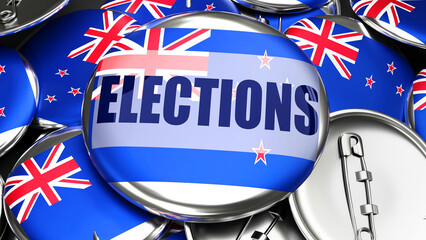

Over last weekend there were two developments in New Zealand of some importance to Australia. The first was that last Friday the incoming Prime Minister, Christopher Luxon of the National Party, went to the Governor-General, Dame Cindy Kiro, to form a three-way coalition government of conservative parties. The second was that on Saturday the National Party’s candidate Andrew Bayly won the supplementary election for Port Waikato bringing the number of National Party MPs up to 49. New Zealanders waited 42 days to know the result of a vote cast on 14 October but now is a good time for me to analyse the election.
As I pointed out in my Switzer Daily article posted on Thursday 19 October (see “Has Voice referendum proved we’re more Anglo than the Poms?”) the term “Anglosphere” covers six countries, the United States of America, Canada, the United Kingdom, Ireland, Australia and New Zealand. The US has a system that separates the executive from the legislature, the others have parliamentary systems that join the executive to the legislature. Of those five, three (the UK, Canada and Australia) elect their lower house by systems of single member constituencies, while two (Ireland and New Zealand) use proportional representation systems, here PR for short.
Consequently, it is not surprising that when a change of government occurs, the winning party takes office immediately in the UK, Canada and Australia – essentially because the winning party gets a share of the seats well in excess of its share of the vote. Hence, in the UK, the Conservative Party led by Boris Johnson in December 2019 won 56.2% of the seats for a vote of 43.65, while in Canada in September 2021 Justin Trudeau’s Liberal Party won 47% of seats for a vote of 32.7% and was by far the biggest single party, so could easily form minority government. The centre left Liberals won 159 seats against 119 for the Conservatives, 33 for the Bloc Quebecois, 25 for the leftist New Democratic Party and just two for the Green Party.
In Australia, Anthony Albanese’s Labor Party won 51% of the seats in May 2022 for a first preference vote of 32.6% – and took over immediately from Scott Morrison’s defeated government. Contrast that with Ireland where the most recent general election took place on 8 February 2020, but Leo Varadkar the defeated Taoiseach (Prime Minister) stayed in office until displaced by the new Prime Minister Micheal Martin on 27 June, 140 days after the general election date.
New Zealand’s type of PR is quite different from Ireland’s but the delay to form a new government is almost always the same. Thus, at the September 2017 election, Jacinda Ardern’s Labour Party won 46 seats compared with 56 seats won by the National Party then led by incumbent Prime Minister Bill English. The election was on 23 September, but Ardern became Prime Minister on 26 October, 33 days later – and only after negotiating a coalition government with the Green Party (8 seats) and the New Zealand First party led by Winston Peters (9 seats). It was an unlikely coalition between parties of the left and populist right. New Zealand First is generally described as “populist” though we in Australia would call it “Hansonite” and the Americans would call it “Trump-lite”. As widely expected, that coalition government did not last – but, as explained below, Ardern did!
Winston Peters and his party have made a comeback at this recent election. He will be the Deputy Prime Minister to Luxon for the first 18 months of a three-year term. For the second 18 months, the Deputy Prime Minister will be David Seymour, leader of the ACT party.
Ardern won re-election for Labour on 17 October 2020 with an even 50% of the party vote from, which it won 54.25 of the seats in the House of Representatives, 65 seats out of 120. That was a unique occurrence under New Zealand’s new PR system, operating from October 1996 to the present day. As is often the case with PR systems, the biggest single party was slightly “over-represented”. In that case, Labour was “over-represented” by 4.2%.
In my Switzer Daily article posted on Tuesday 25 July (“New Zealand will change its government in October”) my prediction was that the combination of the two conventional centre right parties, National and ACT, would win a majority at the general election held on 14 October – and so it seemed to be the case on election night.
However, the counting of late votes favoured parties of the left and the election numbers were finalised last Saturday 25 November. They are 49 for National, 11 for ACT and 8 for New Zealand First. That makes 68. On the left are 34 Labour, 15 for the Green Party and 6 for Te Pati Maori, the party that used to be known simply as “the Maori Party”. That makes a total of 55 seats which means there will be a total House of Representatives of 123 members.
The natural coalition of the centre right would be between National and ACT. New Zealand’s National Party is like Australia’s Liberal Party, the traditional mainstream party of the right. The ACT party, however, is of the modern libertarian right, all for free markets and described as “ideologically Friedmanite” whose letters ACT come from it having started as the Association of Consumers and Taxpayers. Its current leader is David Seymour, member for the Auckland seat of Epsom, which is roughly similar to Australia’s Wentworth. Seymour will be Deputy Prime Minister for the second half of Luxon’s term.
My pre-election prediction that these two parties combined would win a majority of the seats was the basis for my saying “New Zealand will change its government in October”. Wrong! It changed its government late in November. The reason for my being wrong is that 60 seats in a House of Representatives of 123 is not a majority. Although Labour was defeated in October, it continued to govern until last Monday.
Those big party supporters who love the British-Canadian-Australian way of a quick change of government might think that the National Party in New Zealand is hard done by when it gets 38.1% of the vote but needs to negotiate with two other parties to win government. That’s PR for you. However, add 8.6% of the vote for ACT and 6.1% for NZ First and you get 52.8% of the vote. In the case of National, it has 39.8% of the seats for 38.1% of votes, an “over-representation” of 1.7%.
I mentioned above that New Zealand’s type of PR is very different from Ireland’s. The Irish system is candidate based, where New Zealand’s is party based. The Irish system is essentially the same as Hare-Clark in Australia – hence much preferred by yours truly. One of its important features is that when Ireland goes to the polls, everyone knows that 160 members will be elected from 39 multi-member constituencies.
In New Zealand, by contrast, a pundit like yours truly can predict there will be 120 seats, with the National-ACT combination getting 61 seats and a majority - only to find out that there would be 123 seats with the National-ACT combination getting 60 seats which, as noted above, is not a majority. The explanation is that there are two types of members, 72 directly elected from single-member constituencies normally “topped up” by 48 from party lists. However, there will be 51 party list members in the new parliament as a consequence of what is known as “overhang” seats which arise in certain circumstances, the details of which I lack the space to describe here.
Ireland’s system is known technically as “Proportional Representation by means of the Single Transferable Vote” and is the traditional British form of PR. New Zealand, however, decided to copy the German system, known as “Mixed Member Proportional”. Under it in Germany, there are 299 constituencies supposedly “topped up” by 299 members from party lists, so a total of 598. However, the Germans also have overhang seats, known there as “uberhangmandate”, but the most recent election on 26 September 2021 produced 426 members from party lists creating a Bundestag of 735 members in total. I lack the space to explain why there are so many German overhang seats. Anyway, Olaf Scholz, leader of the Social Democratic Party, was sworn into the office of Chancellor on 8 December 2021, 73 days after polling. His is a three-party coalition of Social Democrats, Greens, and the pro-business Free Democratic Party.
Those who dislike the whole idea of PR would say that its worst form is to be found in Israel and The Netherlands. I have considerable sympathy for that view as best illustrated by the recent Dutch general election. Last Friday’s headline “Anti-Islam Wilders wins most seats in Dutch poll” was followed by our being told that the populist anti-Islam party of Geert Wilders had won a shocking one quarter of the seats in parliament. I don’t believe Wilders will be Prime Minister, but I predict it will take four months of negotiation after which we’ll learn that other parties had put together a coalition purely to stop Wilders from getting the top job. Silan Yesilgoz, 46, will become the first female Dutch Prime Minister – yet her party will be only the third largest party in the parliament! She is a former refugee from Turkey and was the first Dutch cabinet minister of non-west European origins.